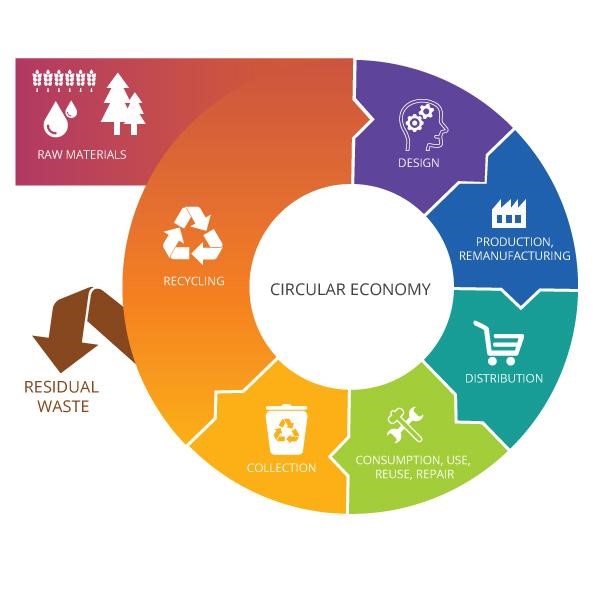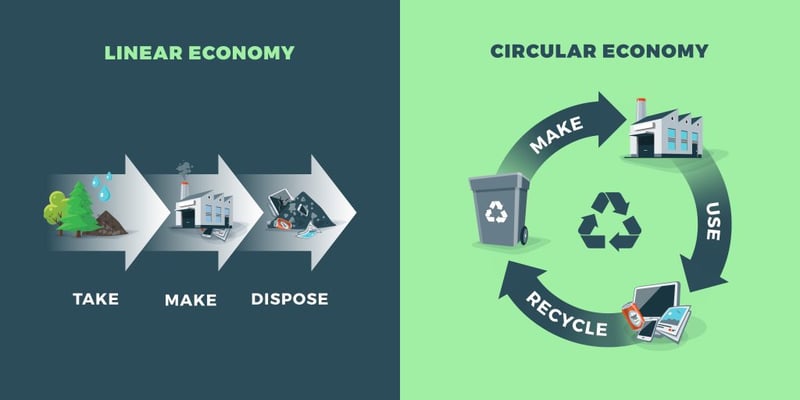What is Circular Economy, and Why Should We Care?
Have you ever imagined a world in which waste does not exist and waste management was synonymous with production? Ever wondered what prosperity looks like in a world of finite resources where production and consumption do not create any detrimental effects on the planet? That’s what a Circular Economy looks like.
Currently, we are living in a ‘Linear Economy’– one that follows the ‘Take-Make-Waste’ model- where natural resources and virgin materials are extracted from the earth, manufactured into products and ultimately disposed into landfills as waste after use. Progress in such an economy is defined by the increasing number of goods produced and sold. But what happens to the value lost from the products after they go through this one-way journey? What happens to those precious metals in a juice can once we are done drinking the juice? According to the Circularity Gap Report, currently, only around 8.6% of all extracted resources in the world are getting recycled or reused, and the rest are entering landfill.
In contrast to this, the Circular Economy is a more restorative and regenerative concept as it aims to close the loop of raw materials, redirect and recycling used products and resources back into the economy and prevent toxic materials from entering landfills. By processes like Reusing, Sharing, Re-manufacturing, Re-purposing and Recycling, this economy changes our perception of waste and asset management and decouples the link between economic growth and rapid consumption levels.
The circular economy offers significant environmental benefits, revolutionising how we interact with resources and waste. By shifting from a linear to a circular model, we can drastically reduce the strain on our planet. This transition emphasises sustainable practices like reusing, remanufacturing, and recycling, which conserve resources and reduce the need for virgin materials. This not only lowers greenhouse gas emissions but also minimises habitat destruction and pollution.
Circular economies reduce energy consumption by repurposing existing materials, cutting down on the energy-intensive processes of extraction and production. For instance, recycling aluminium saves up to 95% of the energy needed to produce new aluminium from raw materials. Additionally, by designing products for durability and easy disassembly, we can extend their lifecycle, further reducing the demand for new resources.
This model also promotes biodiversity by reducing the extraction of raw materials, which often leads to habitat destruction and environmental degradation. By keeping products and materials in use, we limit the waste that ends up in landfills and oceans, protecting wildlife and ecosystems from harmful pollutants.
Furthermore, the circular economy supports innovation in sustainable practices. Companies are encouraged to develop eco-friendly products and processes, fostering a market for green technologies and sustainable solutions. This not only benefits the environment but also creates new economic opportunities and jobs in the green sector.
At Procurement Australia, we are committed to facilitating this shift towards a circular economy. We work closely with our members to implement sustainable procurement practices, helping organisations source products and services that support environmental stewardship. By fostering partnerships and promoting awareness, we aim to make the circular economy an integral part of our operational strategy, ensuring a healthier planet for future generations.

If thoughtfully applied, the circular economy can provide many short-term cost benefits as well as long-term strategic benefits. For example, imagine that a consumer purchases a can of juice and drinks the juice. Now in a linear economy, the producers would have no extended responsibility for the product post-consumption, and the consumer would discard the can in the rubbish bin which would eventually be diverted towards landfill. But if we were to re-think this entire business model in a circular economy, the producers would provide a way for the consumer to return the used can after consumption.
This way, not only would it benefit the consumer on receiving an incentive after return but would also create value for the producers in redirecting the used materials back into the production cycle by reusing or recycling them to make other products requiring metal and lower the costs of purchasing virgin resources.

The circular economy is the way forward, helping to create a culture where more of the materials from the waste streams are captured and recovered. It’s a collection of strategies, old and new, that are together meant to help reshape our global economy and eliminate waste.
It doesn’t aim to stop growth, but rather to align our growth in harmony with the planet’s finite resources so that growth can continue.
At Procurement Australasia, we understand that circular economy is important to the operational strategies of a lot of our members and we are here to support your organisation on the journey from linear to a circular economy. We are partnering with organisations with local and national footprints to help increase awareness around this topic and connect members with potential suppliers to achieve a sustainable business model.
This blog post was created by Tamanna Wadhwani, who currently works with Circular Economy Victoria, a community activation platform dedicated to help accelerate the transition towards a circular economy in Victoria.
Additional resources to learn more:




